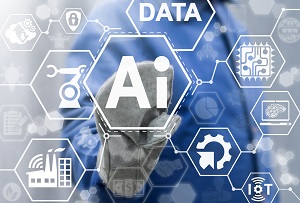
▲圖片來源:insidebigdata
With the right technical infrastructure and data-literate work culture, the challenges with the adoption of data science and machine learning technologies can be easily addressed.
Successful companies today need to be data driven. A survey by NewVantage Partners found that 92% of organizations are increasing their investments in data and artificial intelligence (AI) capabilities. On the flipside however, only 19% of companies feel that they are truly being data driven. This analytics gap continues to widen and conspires to impede organizational process. This gap boils down to one thing: a lack of analytics capacity within organizations. There are both technical and cultural challenges that affect the development of data-driven organizations.
Key Challenges in the Adoption of Data and AI
Any new platform requires the right environment to reach its full potential. This applies to the requirements of data science and the application of all its techniques. There are some key challenges to the adoption and implementation that organizations must overcome before they can successfully become data driven.
Culture Change
The biggest barrier to adoption is people. Employees and executives alike can slow the adoption of data science and machine learning. This is due to fear of being made redundant, lack of understanding of the benefits, and lack of easy access to the technology.
Outdated Architecture
A common issue with organizations is that their infrastructure exists in silos. They are often not integrated and therefore do not work seamlessly together. The access to the data these silos contain becomes complicated. This results in fewer people being able to access the data compared to when an organization invests in modern infrastructure. Migrating to the cloud is a key solution to better infrastructure.
Inefficient Handoffs
As data increases and the need for micro-expertise grows across the data and analytic processes. It is important that automation and collaborative capabilities grow alongside. This will help facilitate seamless interaction between the different professionals who handle the data at multiple stages. Manual hand-offs complicate things and leave room for error. It is a challenge to ensure that all hand-offs across IT personnel, data scientists, ML engineers, and others are seamless.
Lack of Talent
There are several reports to show that there is a constant lack of expert talent in the data science field. With automation taking over data processes, there is an increasing need for overarching capabilities across sectors of data science, ML, and AI. The newer crop of professionals must keep up with a broad spectrum of skills required for data science.
Amidst this is the lack of diversity in data science professionals. A lack of diversity — women and people of colour in this industry poses a real challenge to ethical AI.
Prepare your Organization for Better Implementation
Some best practices can be kept in mind when working on the infrastructure that will allow an organization to overcome the challenges in the adoption of data science and ML technologies.
A Change in Mind Set
The executive team must focus on shifting mindsets within the organization to adopt new data, analytic, and automation practices. Employees need to be assured that AI systems free up expert personnel to do more challenging jobs that can catalyze market disruptors; there is no threat to their jobs. Of course, there is a need for specialized knowledge and an upgrade of skill sets. To facilitate a change in mindset it must begin with the C-suite and find its way down to every employee of an organization.
Bring in the Right Resources
Developing a data-centric mindset grows over time. To aid this process, there is also a need to develop quality resources – a set of tools that help with creating actionable insights across each department of the organization. Every department, from marketing to finance, the operations department, human resources, and the multiple business-related teams, will need access to analytical tools that they can use independently to accelerate analytics.
The Right Reasons and the Right Tasks
To ensure the ease of technology adoption, you need the right kind of business problem. Framing the right business goal to be addressed is key to ensuring you build the right infrastructure to support it. Aspects such as production growth, revenue increase, and reduction of business costs are all good foundations to build around.
Taking small, incremental steps to developing a data-centric work culture is the way to go in the adoption of data science, ML, AI, and other technologies. It requires significant planning, reviewing, and customized development, but will ensure a dominant edge to any organization that does it right.
轉貼自: insidebigdata
若喜歡本文,請關注我們的臉書 Please Like our Facebook Page: Big Data In Finance


留下你的回應
以訪客張貼回應